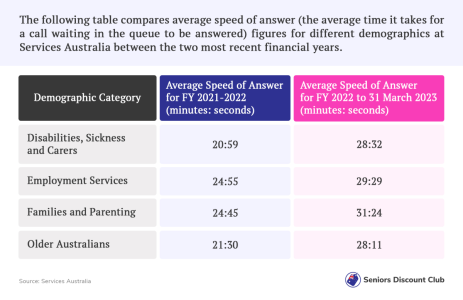Centrelink struggles to meet demand as wait times skyrocket
- Replies 43
Staying connected in today's tech-driven world can sometimes be a real headache, especially when it involves dealing with government agencies.
While technology has undoubtedly transformed the way we communicate, in many ways for the better, it hasn't quite reached its full potential in terms of efficiency and effectiveness.
When it comes to critical service providers like Centrelink, any hiccup in operations affects all of us. It disrupts our comfort, convenience, and our patience levels as well.
Unfortunately, Centrelink has recently found itself in the spotlight for an issue that has left many Australians less than pleased: longer waiting times on the phone.
It seems that despite the advancements in technology, our frustrations about waiting for our calls to be answered remain largely unaddressed.

Waiting may be a part of life, whether it's for the bus, the kettle to boil, or the grandkids to visit. But importantly, waiting is a pain when it's our hard-earned money and financial security at stake.
New figures reveal that millions of Aussies struggling with the cost-of-living crisis are spending more time than ever waiting on phone lines for their calls to be answered at Centrelink.
Statistics sourced by the opposition indicate that the average wait time across all social security and welfare calls to Centrelink has made a considerable jump from 14 minutes and 14 seconds during the 2021-22 financial year to a whopping 20 minutes and 22 seconds this financial year.
What is contributing to these issues? According to reports, a combination of factors is at play. One factor is the reduced staffing levels and tighter budget that followed the post-pandemic era. Additionally, there is a significant number of Australians who still prefer calling Centrelink instead of utilising digital channels.
Between July and March last year, over six million calls related to parenting and families were made to Centrelink. On average, callers had to wait for approximately 31 minutes and 24 seconds, an increase of nearly seven minutes compared to the previous year's average waiting time of 24 minutes and 45 seconds.
In stark contrast, during the pandemic, when the workforce was substantially expanded, the same individuals experienced a wait time of just eight minutes to have their calls answered.
Another group affected by the prolonged wait times are individuals seeking assistance with disabilities, sickness, and carers. In 2021-2022, the average wait time for this group was 20 minutes and 59 seconds. However, between July 2022 and May 2023, the wait time increased significantly to 28 minutes and 23 seconds.
Furthermore, it's not just the social security calls struggling to navigate Centrelink's telecommunications system. Wait times for other Services Australia programs, such as Medicare and Child Support, have also significantly increased.
The current situation at Centrelink is occurring at a crucial time, following Services Australia's recent decision not to extend its $343 million contract with the welfare agency Serco. This move has had a significant impact, resulting in the loss of 600 jobs.
To provide some background, prior to the onset of the Covid-19 pandemic in March 2020, Services Australia had already cut a substantial number of jobs towards the end of 2019. However, during the pandemic, Centrelink had to swiftly hire additional staff to accommodate the rising number of individuals needing welfare or other forms of support.
Nevertheless, as the world gradually adjusted to the 'new normal,' Centrelink has been working towards returning staffing numbers to pre-pandemic levels since last June. Understandably, this adjustment has impacted the quality of service provided, given the increased workload and decreased staff resources.
The opposition's spokesman for government services, Paul Fletcher, has expressed concerns over the escalating waiting times, stating that the government is failing some of the most vulnerable Australians.
'This new data confirms that call wait times have skyrocketed under Labor. This is amid a cost of living crisis when Australians need government services and payments more than ever for support,' Mr Fletcher said.
He further emphasised that the numbers are irrefutable, painting a grim scenario of a system that is faltering.
'The government demonstrably doesn't want to listen to our most vulnerable Australians—they would rather put them on hold. Government Services Minister Bill Shorten needs to put processes in place to ensure customers are no longer adversely impacted,' he went on to say.
A spokesperson for Mr Shorten has emphasised that recent budget papers demonstrate the 'agility' of Services Australia, highlighting their ability to adapt resources in order to maximise frontline staffing levels.
'This includes drawing from their emergency response capabilities and bringing staff back in-house,' they said.
However, Mr Fletcher called for Mr Shorten to clarify the number of those 600-plus jobs that have transitioned into employment within the Australian Public Service, the associated costs, and the strategies in place to address the concerning surge in wait times due to the staffing shortage.
'Mr Shorten needs to be honest with the public,' he said.

Navigating Centrelink's phone lines can often feel like searching for a needle in a haystack. Fortunately, there is some good news. Services Australia acknowledges the challenges and is continuously working towards enhancing its service and meeting the growing demands.
The Albanese government has also strongly committed to 'strengthening' the agency.
Patience is indeed a virtue, but when it comes to unfair waiting times, even the most patient individuals can be put to the test. It is our hope that this situation improves sooner rather than later, as time is of the essence when dealing with important matters.
We would like to hear from you, members! Have you experienced the frustration of waiting an extended period just to speak to a Centrelink representative? How did the situation go for you? Please share your experiences and stories with us in the comments section below.
While technology has undoubtedly transformed the way we communicate, in many ways for the better, it hasn't quite reached its full potential in terms of efficiency and effectiveness.
When it comes to critical service providers like Centrelink, any hiccup in operations affects all of us. It disrupts our comfort, convenience, and our patience levels as well.
Unfortunately, Centrelink has recently found itself in the spotlight for an issue that has left many Australians less than pleased: longer waiting times on the phone.
It seems that despite the advancements in technology, our frustrations about waiting for our calls to be answered remain largely unaddressed.

Centrelink's average wait times have significantly increased due to workforce challenges. Credit: Shutterstock.
Waiting may be a part of life, whether it's for the bus, the kettle to boil, or the grandkids to visit. But importantly, waiting is a pain when it's our hard-earned money and financial security at stake.
New figures reveal that millions of Aussies struggling with the cost-of-living crisis are spending more time than ever waiting on phone lines for their calls to be answered at Centrelink.
Statistics sourced by the opposition indicate that the average wait time across all social security and welfare calls to Centrelink has made a considerable jump from 14 minutes and 14 seconds during the 2021-22 financial year to a whopping 20 minutes and 22 seconds this financial year.
What is contributing to these issues? According to reports, a combination of factors is at play. One factor is the reduced staffing levels and tighter budget that followed the post-pandemic era. Additionally, there is a significant number of Australians who still prefer calling Centrelink instead of utilising digital channels.
Between July and March last year, over six million calls related to parenting and families were made to Centrelink. On average, callers had to wait for approximately 31 minutes and 24 seconds, an increase of nearly seven minutes compared to the previous year's average waiting time of 24 minutes and 45 seconds.
In stark contrast, during the pandemic, when the workforce was substantially expanded, the same individuals experienced a wait time of just eight minutes to have their calls answered.
Another group affected by the prolonged wait times are individuals seeking assistance with disabilities, sickness, and carers. In 2021-2022, the average wait time for this group was 20 minutes and 59 seconds. However, between July 2022 and May 2023, the wait time increased significantly to 28 minutes and 23 seconds.
Furthermore, it's not just the social security calls struggling to navigate Centrelink's telecommunications system. Wait times for other Services Australia programs, such as Medicare and Child Support, have also significantly increased.
The current situation at Centrelink is occurring at a crucial time, following Services Australia's recent decision not to extend its $343 million contract with the welfare agency Serco. This move has had a significant impact, resulting in the loss of 600 jobs.
To provide some background, prior to the onset of the Covid-19 pandemic in March 2020, Services Australia had already cut a substantial number of jobs towards the end of 2019. However, during the pandemic, Centrelink had to swiftly hire additional staff to accommodate the rising number of individuals needing welfare or other forms of support.
Nevertheless, as the world gradually adjusted to the 'new normal,' Centrelink has been working towards returning staffing numbers to pre-pandemic levels since last June. Understandably, this adjustment has impacted the quality of service provided, given the increased workload and decreased staff resources.
The opposition's spokesman for government services, Paul Fletcher, has expressed concerns over the escalating waiting times, stating that the government is failing some of the most vulnerable Australians.
'This new data confirms that call wait times have skyrocketed under Labor. This is amid a cost of living crisis when Australians need government services and payments more than ever for support,' Mr Fletcher said.
He further emphasised that the numbers are irrefutable, painting a grim scenario of a system that is faltering.
'The government demonstrably doesn't want to listen to our most vulnerable Australians—they would rather put them on hold. Government Services Minister Bill Shorten needs to put processes in place to ensure customers are no longer adversely impacted,' he went on to say.
A spokesperson for Mr Shorten has emphasised that recent budget papers demonstrate the 'agility' of Services Australia, highlighting their ability to adapt resources in order to maximise frontline staffing levels.
'This includes drawing from their emergency response capabilities and bringing staff back in-house,' they said.
However, Mr Fletcher called for Mr Shorten to clarify the number of those 600-plus jobs that have transitioned into employment within the Australian Public Service, the associated costs, and the strategies in place to address the concerning surge in wait times due to the staffing shortage.
'Mr Shorten needs to be honest with the public,' he said.
Key Takeaways
- Centrelink's workforce is failing to meet demand, resulting in longer wait times for telephone support, according to new data.
- The average wait time has increased from 14 minutes and 14 seconds in the 2021-22 financial year to 20 minutes and 22 seconds this financial year.
- Services Australia has recently decided not to renew its $343 million contract with welfare agency Serco, affecting 600 jobs.
- The opposition's spokesman for government services, Paul Fletcher, has called for a comprehensive review of Services Australia's operations due to growing concern over Centrelink's inefficient service performance.
Navigating Centrelink's phone lines can often feel like searching for a needle in a haystack. Fortunately, there is some good news. Services Australia acknowledges the challenges and is continuously working towards enhancing its service and meeting the growing demands.
The Albanese government has also strongly committed to 'strengthening' the agency.
Patience is indeed a virtue, but when it comes to unfair waiting times, even the most patient individuals can be put to the test. It is our hope that this situation improves sooner rather than later, as time is of the essence when dealing with important matters.
We would like to hear from you, members! Have you experienced the frustration of waiting an extended period just to speak to a Centrelink representative? How did the situation go for you? Please share your experiences and stories with us in the comments section below.








